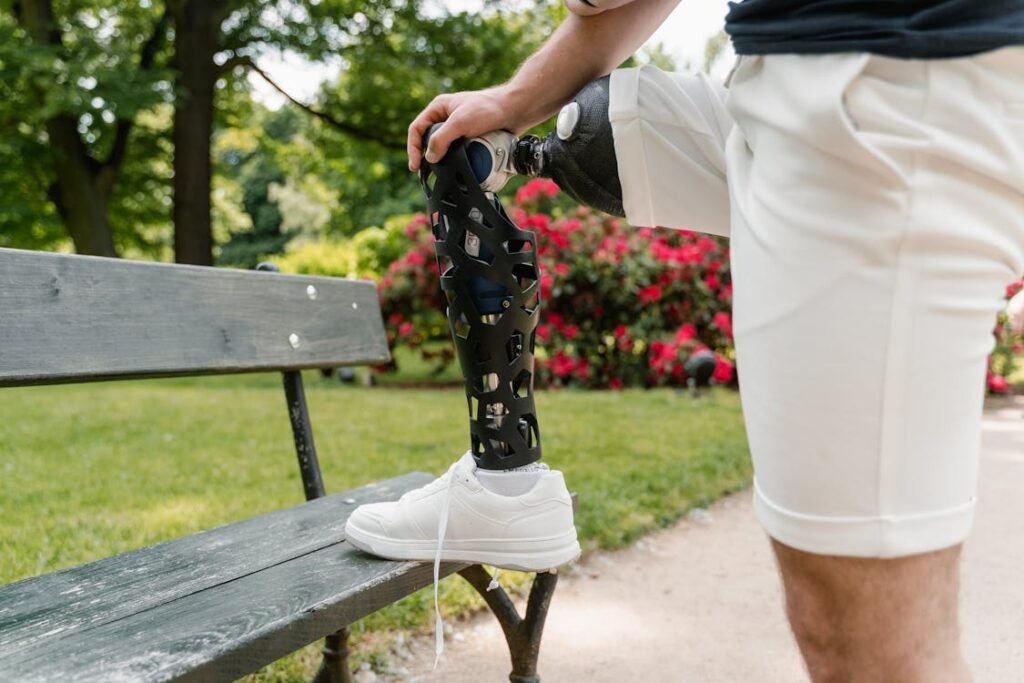When someone wears a prosthetic limb every day, their comfort depends on more than just the fit or alignment. It also depends heavily on the material that touches their skin—the socket interface. For people with sensitive skin, this layer is incredibly important. It can either protect the limb and help them move freely, or cause pain, irritation, and even wounds that make wearing the prosthesis impossible.
At Robobionics, we’ve seen this struggle up close. In India, where heat, humidity, and long hours of wear are part of everyday life, many prosthetic users with sensitive skin find it hard to wear their limb comfortably for more than a few hours. The material inside the socket gets warm, sticky, and causes itching or even rashes. That’s why the search for better socket interface materials has become a serious focus—not just for comfort, but for health, mobility, and quality of life.
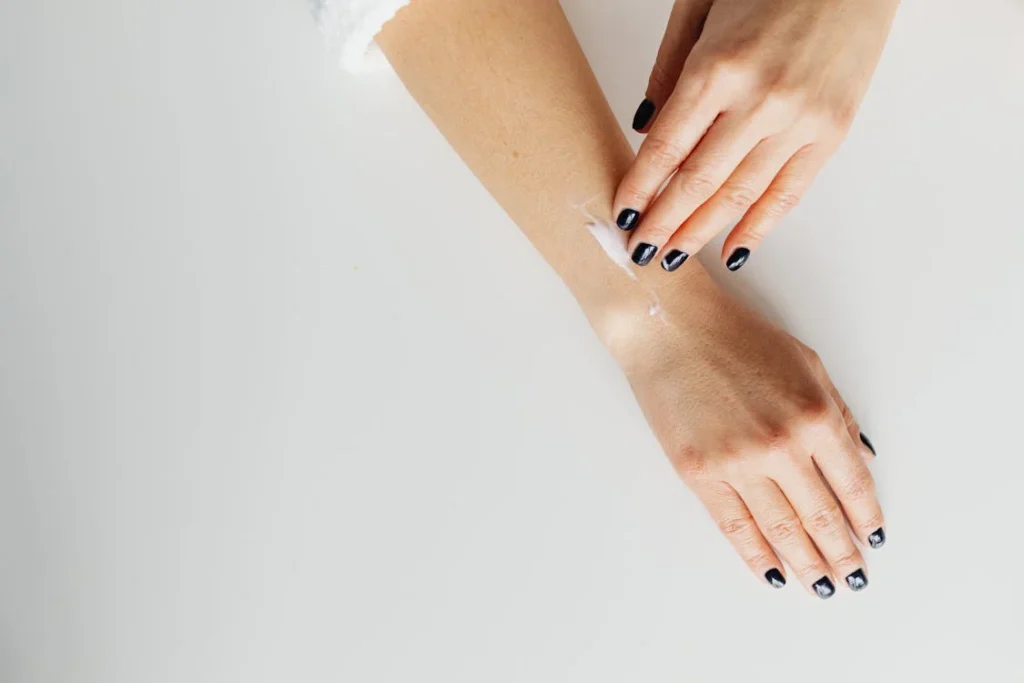
Understanding the Problem: Why Sensitive Skin Needs Special Care
The Daily Challenge of Prosthetic Wear
Wearing a prosthetic limb may seem like a simple routine from the outside. But for those who use one every day, especially with sensitive skin, it’s a constant balancing act.
The skin on a residual limb goes through pressure, rubbing, moisture buildup, and heat every hour the socket is worn. These effects are more intense in warmer climates, where sweat and humidity are unavoidable.
When the interface material inside the socket isn’t right, the skin reacts. Redness appears. Blisters form. The user may begin to feel stinging or a constant itch.
Over time, that irritation turns into open wounds. And once the skin breaks, the prosthesis can no longer be worn. This means the user loses mobility, becomes dependent again, and may feel frustrated or helpless.
It’s not just about a rash. It’s about losing freedom.
That’s why materials inside the socket must do more than just fit. They have to protect. They must allow the skin to breathe.
They must prevent friction while staying snug. And they must do all this for long hours without causing breakdown.
Not All Skin Is the Same
Some people can wear basic socket liners for years without any issues. But many others can’t go a full day without discomfort.
The skin on the residual limb is often more delicate than skin elsewhere. This is especially true for people with thin skin, poor circulation, recent surgeries, or health conditions like diabetes.
What makes it more complex is that skin sensitivity varies from person to person. One user may find silicone liners soothing.
Another may react badly to them. Some people need more cushioning. Others need cooler materials. It’s never a one-size-fits-all problem.
At Robobionics, we’ve learned that understanding a person’s skin is just as important as understanding their limb. That’s why we ask questions not just about fit, but about how the skin feels at the end of the day.
We ask how much they sweat. Whether they’ve ever had a rash from liners. If they feel pressure in certain areas more than others.
The answers guide us toward choosing the right material. And as new materials are developed around the world, we bring the best of those advances to our users right here in India.
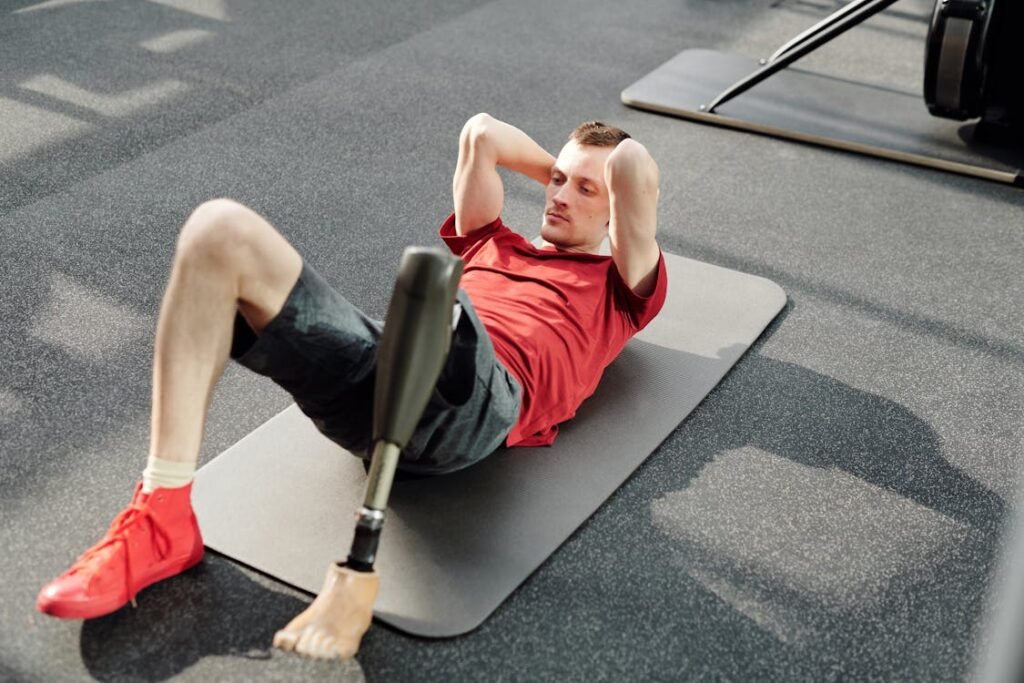
Traditional Materials and Their Limitations
The Old Way of Thinking
Years ago, most prosthetic sockets were lined with basic foams or hard plastics. These worked well enough to shape the limb and hold it in place.
But they were never really designed with skin health in mind. They trapped heat. They absorbed sweat. And they became a breeding ground for bacteria.
Even as silicone liners became more common, they weren’t perfect. While softer than plastic, silicone has a tendency to retain heat.
For someone walking several kilometers a day or working in outdoor conditions, this quickly becomes uncomfortable. The skin can soften too much, making it more likely to break or peel.
Another issue is with the way traditional liners grip the skin. Many older designs rely on a tight hold to keep the socket in place.
But for sensitive skin, that tightness can be too much. It creates constant pressure on a few key points, leading to bruising or deep-tissue irritation.
What we found is that these materials didn’t fail because they were poorly made. They failed because they were made for a general user, not for a user with specific skin needs.
The Invisible Problem of Moisture
Moisture is one of the biggest enemies of sensitive skin inside a prosthetic socket. As the user moves, sweat builds up. If the material doesn’t let that moisture escape, it gets trapped between the liner and the skin.
Over time, this weakens the skin barrier. What begins as a mild itch can quickly become an infection.
Some older liners absorb sweat but don’t dry quickly. Others resist moisture but become slippery when wet, which leads to movement inside the socket.
Either way, the result is the same: friction, movement, and breakdown.
At Robobionics, we’ve seen users who had to stop using their prosthetic limbs entirely during the hot season simply because their skin couldn’t handle the trapped heat and sweat.
That’s unacceptable. People deserve solutions that work all year round—not just in a cool room.
This is why researchers and prosthetic engineers around the world have focused in recent years on solving these skin challenges using smarter, more adaptive materials.
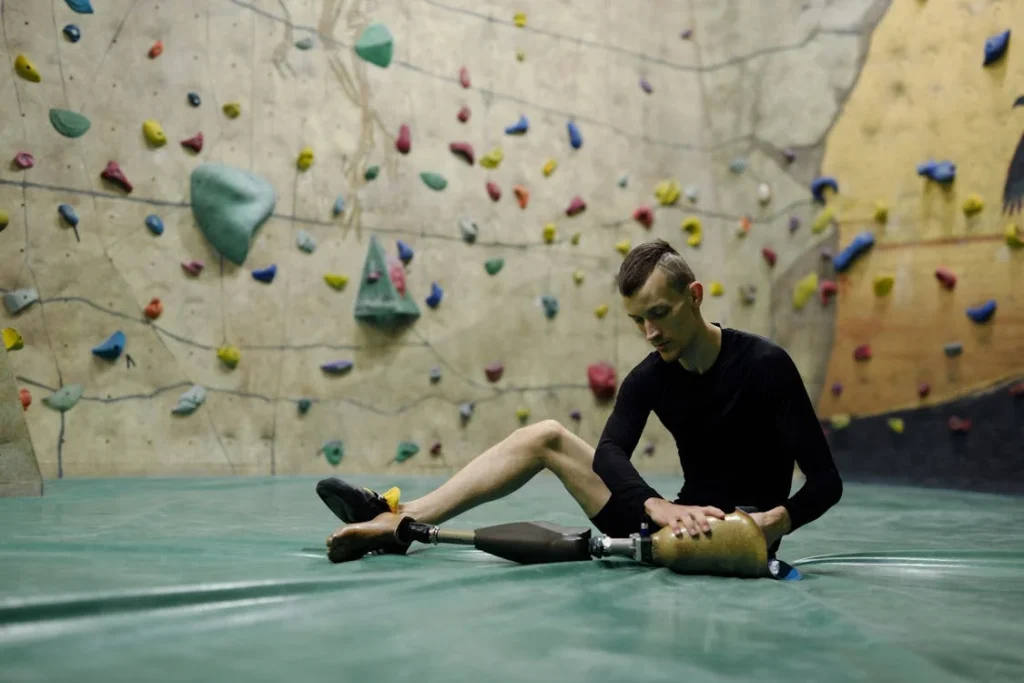
A New Generation of Socket Interface Materials
The Shift Towards Skin-Friendly Innovation
In the past decade, the prosthetics industry has seen a significant change in how socket interfaces are designed.
Instead of just focusing on support and grip, more attention is now being given to how materials interact with human skin—especially skin that is fragile, reactive, or easily injured.
This shift has opened the door to a new generation of interface materials that are designed from the inside out, starting with the user’s skin and building outward.
These newer materials are no longer just soft. They are smart—engineered to manage heat, moisture, friction, and pressure all at once.
The goal is not just to cushion the limb but to create a healthy environment around it, one that supports the skin and allows it to recover and breathe, even during intense or long-term use.
At Robobionics, we closely follow global developments in this field. But we don’t just read about them—we test them in real-life conditions, with real users, across India.
We want to know how a material performs not in a controlled lab, but in the dust, heat, and humidity of daily life here.
Breathable Liners: Letting the Skin Breathe Again
One of the biggest breakthroughs in recent years is the introduction of breathable liner systems. These are made with multi-layered fabrics that allow air to pass through while still maintaining a snug grip.
The inner layer is designed to sit gently against the skin, often with anti-bacterial or hypoallergenic coatings. The middle layer allows for airflow and moisture escape.
The outer layer provides strength and structure to hold the socket firmly in place.
This design helps reduce the moisture problem that affects so many users in warm climates.
When sweat is allowed to evaporate instead of getting trapped, the skin stays cooler and drier. And when the skin stays dry, it stays stronger and less prone to damage.
These liners also use materials that stretch in multiple directions, adjusting naturally to changes in limb shape throughout the day.
This flexibility helps prevent pressure sores and reduces the number of times a user has to adjust or remove the socket.
Our users who switch to breathable liners often report immediate improvements.
They say the heat feels less intense, their skin doesn’t burn by the end of the day, and they no longer feel like they’re “peeling” the prosthetic off at night.
Medical-Grade Silicone, Reimagined
While silicone remains one of the most common materials used in socket interfaces, it has also evolved.
Traditional silicone was often dense and less forgiving, causing problems for those with delicate or dry skin. But today’s medical-grade silicone is lighter, softer, and more responsive.
These new blends are infused with skin-soothing agents and are designed to maintain a smooth, gentle surface even during movement.
Some are made with additives that fight bacteria or resist fungal growth, addressing one of the hidden causes of rashes and infections.
Modern silicone liners also hold their shape better over time. They don’t harden or crack with repeated use, which means less risk of rough edges irritating the skin.
They’re also easier to clean, and many are machine-washable or quick-drying—another benefit for daily hygiene.
We’ve worked with several users who had previously given up on silicone because of itching or sweat buildup.
With the newer medical-grade versions, many have found they can return to using silicone without discomfort, and with greater skin health overall.
Advances in Gel Interfaces
Gel materials have long been used in prosthetics for their cushioning effect, but they used to come with drawbacks. Older gel liners were sticky, heavy, and retained heat.
But that’s changed. The latest gel interfaces use lightweight, breathable gel polymers that mold gently to the skin while allowing air to circulate.
These gels spread pressure evenly across the surface of the limb, which is especially helpful for users with sharp bone edges, scar tissue, or very thin skin.
They don’t press too hard in one area but rather adapt to the body’s natural shape. This reduces the chance of localized irritation or deep tissue pain.
One of the great advantages of modern gel liners is how they reduce micro-movement. They “grip” the limb just enough to prevent sliding, without pulling or rubbing.
This means fewer friction points and less risk of blisters or ulcers.
We recommend gel liners especially for users recovering from recent surgeries, as they provide soft protection while the skin is still healing.
They can also be a great solution for elderly users who may have thinner or more delicate skin.

Hybrid Materials: Blending Strength with Softness
The Best of Both Worlds
As prosthetic design continues to evolve, one of the most promising developments has been the creation of hybrid interface materials.
These materials are crafted by combining the strengths of different components—like gel, silicone, and breathable fabrics—into a single system that provides both support and comfort.
The goal of hybrid materials is to eliminate the need for trade-offs. In the past, if a user wanted maximum softness, they might have had to give up firmness.
If they needed a cooler material, it might have lacked durability. But now, by layering or weaving different textures and technologies together, manufacturers can offer interfaces that adjust to both the environment and the skin.
At Robobionics, we often suggest hybrid liners for users with multiple skin challenges. For example, someone might have dry, sensitive skin along the top of the limb but experience pressure pain near the base.
With a hybrid liner, we can select a model that has cooling, breathable fabric along the top and a cushioned gel or silicone layer where it’s needed most.
This kind of custom matching allows for far greater skin protection and overall stability.
Adapting Throughout the Day
One of the lesser-known struggles of prosthetic users is how much their residual limb changes throughout the day.
It can swell in the morning, shrink by evening, or respond differently depending on the user’s activity, diet, or environment.
This constant fluctuation means that a socket that fits perfectly at 9 a.m. might feel tight or loose just a few hours later.
Hybrid interface materials are particularly good at handling these changes. Many of them include stretch zones that allow for expansion without pressure.
Others use memory foam-like components that conform to the limb’s shape but return to their original form when not in use.
These dynamic adjustments reduce the risk of friction, which is a leading cause of skin problems.
Some newer hybrid liners even use temperature-sensitive layers. These materials become more flexible as they warm with body heat, which helps the liner adapt more closely to the limb after a few minutes of wear.
That added softness doesn’t just feel better—it protects the skin from sudden pressure shifts during movement.
Creating Stability Without Sacrificing Skin Health
One of the biggest misconceptions about prosthetics is that a tight grip equals stability. But anyone with sensitive skin knows that too much pressure in the wrong place can do more harm than good.
That’s where hybrid materials shine. They provide structure and hold, but they also distribute weight and pressure in smarter ways.
Instead of relying on one central area to do all the holding, hybrid liners spread the grip across multiple points. This creates a more balanced connection between the limb and the socket.
The result is a more secure fit that doesn’t rely on squeezing or pressing hard against sensitive spots.
For our users who are active—those who walk long distances, ride scooters, work on their feet, or even play sports—this balance between hold and protection is essential.
It allows them to move freely without worrying that their prosthesis will slide or cause damage. They don’t need to choose between staying active and staying comfortable.
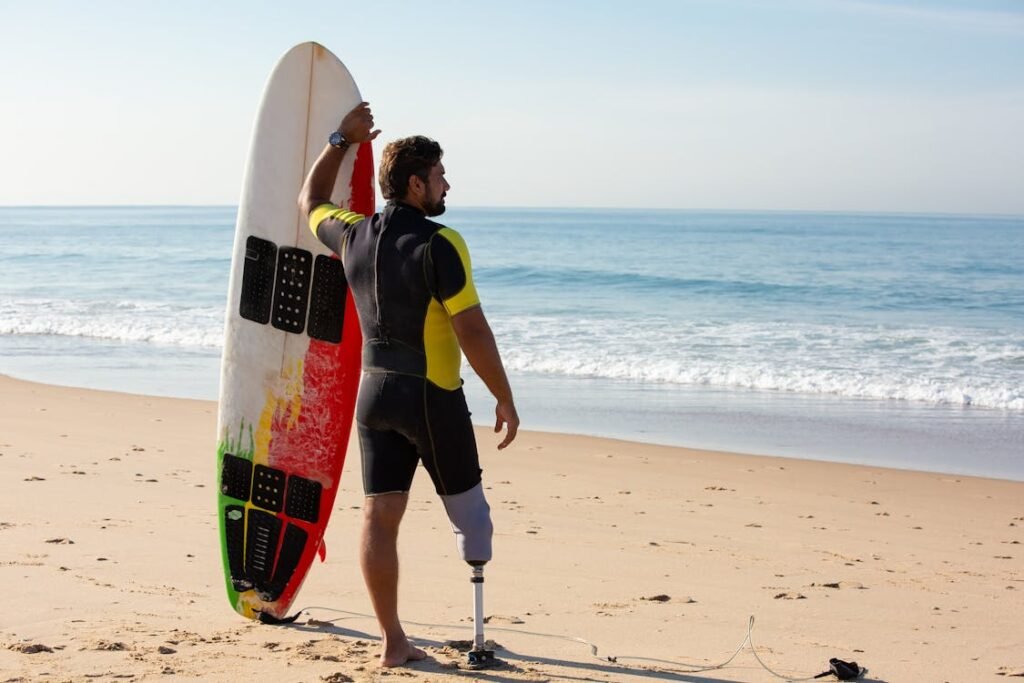
Material Choice as a Personal Journey
No Universal Solution
As much as technology has advanced, there’s no single material that works for everyone. What feels soft to one person may feel sticky to another.
What keeps one user cool may leave another sweating. And what one person wears comfortably for 12 hours might irritate someone else after just 30 minutes.
That’s why the process of finding the right socket interface material is personal. It takes testing, feedback, and sometimes a little patience.
At Robobionics, we never rush this step. We always tell our users that choosing their interface is like choosing a second skin—it has to feel right, not just look right.
We offer test fittings with different liners, let users try them in real-world conditions, and check in regularly to adjust based on feedback.
Our goal is not to sell the most expensive material or the newest trend. It’s to find what works for that person, for their skin, their lifestyle, and their goals.
We also educate users on how to care for their interface materials. No matter how advanced the liner is, if it’s not cleaned or dried properly, it won’t protect the skin the way it should.
Simple steps—like washing with mild soap, drying thoroughly, and storing the liner in a cool place—can extend the life of the material and prevent skin issues.

Meeting Real Needs: Material Innovation in the Indian Context
Designing for Heat, Humidity, and Real-World Conditions
India presents a unique challenge for prosthetic users. High temperatures, high humidity, frequent sweating, and a lot of dust in the air—these are conditions many prosthetic manufacturers abroad don’t fully consider.
Most advanced socket interface materials are developed in labs in cooler climates, where users don’t have to think about heat rash or sweat buildup as daily concerns.
But here, those problems are part of everyday life.
At Robobionics, we’ve worked with users from the coastal heat of Chennai to the dry, dusty streets of Jaipur. In every corner of India, skin sensitivity is heightened by the climate.
That’s why we don’t just rely on the technical data provided by global manufacturers. We put these materials through real-world trials.
We test them in our conditions, with our people, during hot days and long walks. We listen closely to what users feel—not just during the first hour, but at the end of the day, when discomfort tends to build.
Many imported liners, for example, claim to offer moisture resistance. But when worn in peak summer months here, they often trap sweat inside. That leads to softening of the skin, which leads to irritation.
So, we began working with suppliers who could tweak or custom-manufacture liners with added venting or faster drying rates.
We focused on sourcing breathable hybrid fabrics and cooling gel interfaces that hold up better in warm environments.
We also educate users on how to manage heat with their prosthesis—wearing breathable clothing, using powders approved by skin doctors, and removing the prosthesis at intervals if needed.
Material is only one part of the equation. The way it’s used, cleaned, and cared for matters just as much.
Durability Over Time
Another key factor we focus on is longevity. A liner might feel great in the first month, but how will it perform after six? In India, prosthetic users often wear their limbs for long hours, sometimes without a break.
Many travel long distances, work physically demanding jobs, or live in rural areas where prosthetic maintenance is harder to access.
This means socket interface materials must last. They must keep their shape, softness, and grip over time—even when cleaned in less-than-ideal conditions or worn with less-than-perfect hygiene routines.
Some users may not have access to air conditioning or dryers. Materials must be tough enough to survive that.
We look for materials that hold up to frequent donning and doffing. We check if the outer surface starts peeling, if the inner lining cracks or hardens, and how the edges behave after weeks of bending.
These aren’t small details—they’re the difference between a liner that supports daily life and one that becomes a problem users try to avoid.
That’s why we often recommend materials that strike a middle ground—not just the most cutting-edge, but the most reliable in the long run.
Affordability and Access
Cutting-edge materials often come with a high price tag. And while users in metro cities may have more choices, many in smaller towns or rural areas are working with tighter budgets.
That doesn’t mean they deserve less comfort or protection. It just means we have to be smarter about options.
One of our proudest efforts at Robobionics has been finding cost-effective alternatives to premium liners.
By working closely with material suppliers and modifying standard liners for local use, we’ve developed budget-friendly options that still offer breathability, softness, and skin safety.
We’ve also created modular socket designs that allow liners to be changed without remaking the whole prosthesis.
This means users can try different materials over time without needing to replace everything—a more sustainable and affordable approach.
Our team doesn’t just look at the price tag. We look at value—how many hours of comfortable wear can this material give? How much downtime will it prevent? How many skin problems can it help avoid? The answers to these questions guide our recommendations.
We believe that skin care, comfort, and quality of life should never be limited by cost. That’s why we always offer flexible options, explain the pros and cons honestly, and support our users no matter what they choose.
Conclusion
Sensitive skin shouldn’t stand in the way of a full and active life with a prosthetic limb. With the latest advances in socket interface materials—from breathable fabrics and medical-grade silicone to innovative hybrid designs—users now have more choices than ever before. These materials are not just softer or lighter; they’re smarter, more adaptive, and built to protect the skin in real-world conditions.
At Robobionics, we combine this global innovation with deep local understanding. We test every material in India’s climate, with Indian users, and tailor every solution to individual needs. Because for us, a socket isn’t just a piece of equipment. It’s the connection point between technology and the human body—between mobility and freedom.
If you or someone you know is struggling with skin discomfort while using a prosthetic, don’t settle. The right material can change everything—from how your skin feels to how confident you are in every step. Let’s build a future where sensitive skin doesn’t hold anyone back. Let’s make comfort standard, not optional.



